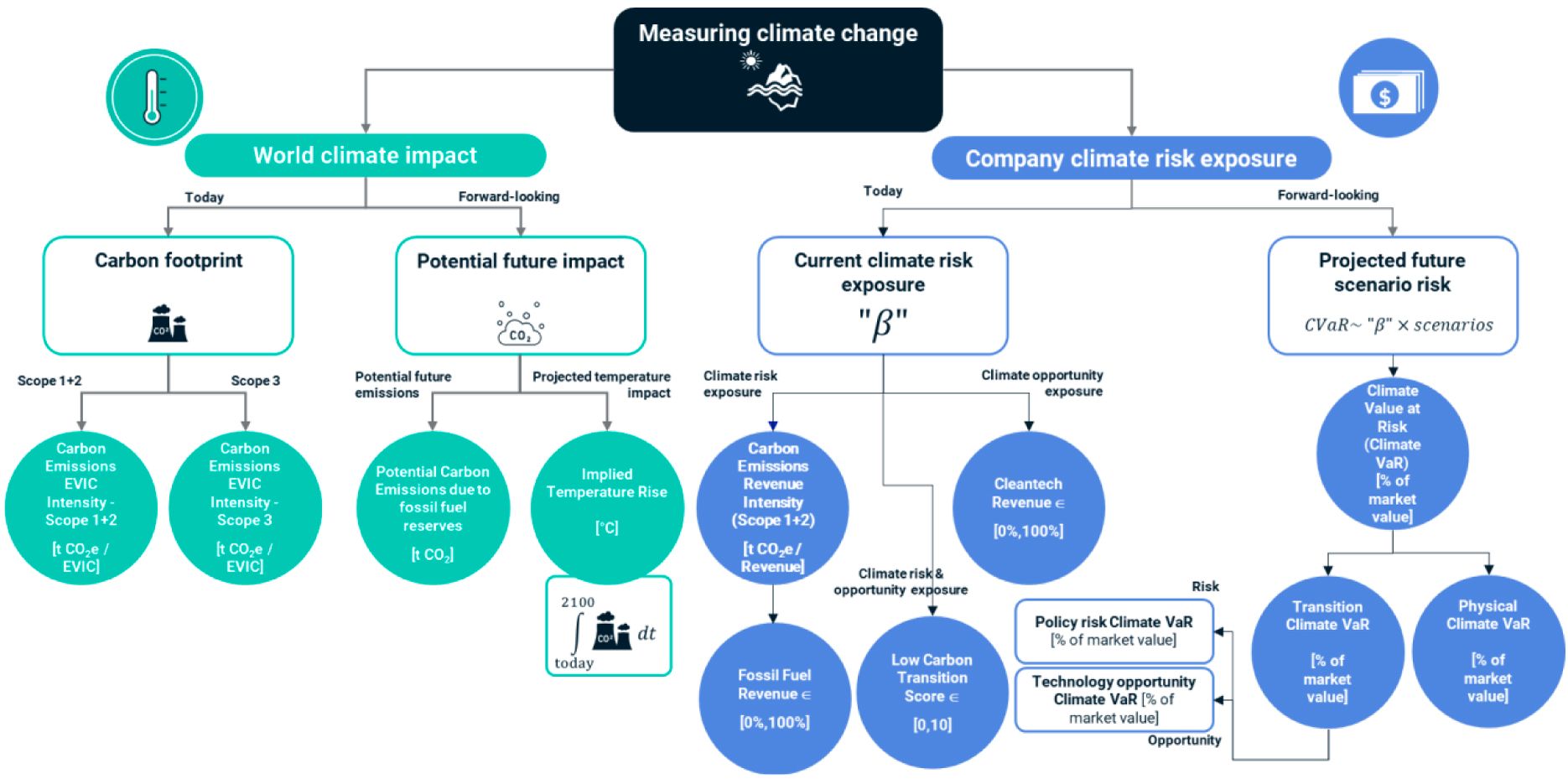How to Evaluate Climate Metrics and Avoid the Big Confusion
- Climate metrics can differ substantially in terms of scope, objectives and applicability. It is thus important for investors to select the right set of metrics to support them in meeting their climate-investing objectives.
- Clarifying the questions climate metrics are meant to address and understanding their potential applicability for different use cases can help investors select the right set of metrics.
- The following two-step process may help: 1) identify a broad set of climate metrics based on their general scope and objectives, and 2) refine the metrics further according to specific portfolio requirements.
A climate metrics selection toolkit
Source: MSCI ESG Research.
Step 1: Identify key metrics and understand the purpose of each
In the first step, investors can identify a broad list of relevant climate metrics by better understanding the scope and objectives of each metric. Using a decision-tree, as shown in the exhibit below, these can then be mapped to their portfolio's broad climate objectives.
The first layer of the tree distinguishes between climate metrics that measure climate impact and those that measure climate risk:
- Metrics that measure climate impact are either directly measured as a temperature impact, such as implied temperature rise, or have explanatory power for temperature rise in the atmosphere, such as absolute Scope 1 emissions measured in metric tons of CO2e.1
- Metrics that assess climate risk2 either estimate potential financial gains or losses as a proportion of a company's enterprise value, such as climate value at risk (climate VaR), or indicate risk or opportunity exposures, which may explain potential financial risk under certain climate scenarios.
MSCI's climate impact vs. climate risk metrics decision-tree

Source: MSCI ESG Research.
As detailed in our recent paper, "Understanding MSCI's Climate Metrics," it is important to understand the investment questions each of these metrics answers. As an example, the following exhibit compares the investment question addressed by MSCI's status quo metric Carbon Emissions EVIC Intensity and the forward-looking measure Implied Temperature Rise.
Example of questions addressed by MSCI's climate metrics
Source: MSCI ESG Research.
Step 2: Refine the list of metrics
In the second step, investors can refine the initial list of climate metrics after understanding the requirement of the different stages in their climate-investment process (see exhibit below) and potential applicability of different metrics to those requirements. We present four key criteria to better understand the potential applicability of different climate metrics.
Different use cases in the climate-investment process
Source: MSCI ESG Research.
First, an investor's climate strategy to achieve their climate objectives can be a key factor in determining a metric's applicability. For example, the MSCI Carbon Emissions Revenue Intensity and Fossil Fuel Revenue metrics can both be used to address current climate risk in a portfolio. However, our Carbon Emissions Revenue Intensity may be more aligned with a low-carbon investment strategy compared to Fossil Fuel Revenue, which may be better suited for an ex-fossil fuel investment strategy.
Second, an investor may find an industry-standard climate metric useful as a primary metric for reporting, stewardship or target setting, where the audience includes a broad group of stakeholders. For example, metrics such as MSCI Carbon Emissions EVIC Intensity, Carbon Emissions Revenue Intensity and Cleantech Revenue have been mentioned by several regulatory and non-regulatory initiatives and can thus be considered generally acceptable or industry-standard metrics.
Third, for portfolio construction, the stability of the climate metrics may be a key consideration for some investors. Metrics which are highly volatile due to non-climate factors such as revenue or enterprise value could lead to unwanted volatility in the portfolio.
And finally, the availability of historical data may be an important consideration for some investors who need a metric that allows them to back-test their portfolio's climate strategy.
Climate metrics: A key tool to support climate-investing objectives
As climate investing becomes mainstream, putting climate ambition into action will require the right set of tools, including suitable climate metrics for each climate-investing use case to measure, monitor and communicate progress. Investors could consider their broad climate objective or several other criteria to find the most suitable metrics.
Further Reading
Implementing Net-Zero: A Guide for Asset Owners
Net-Zero Alignment: Engaging on Climate Change
Understanding MSCI's Climate Metrics
Register Now: Getting to Grips with Climate Metrics — A Comprehensive Webinar
Climate Metrics Series Part 1: Measuring climate change – what metrics should you use?
Climate Metrics Series Part 2: Ranking sectors by carbon footprint
Climate Metrics Series Part 3: Exploring the effect of climate change on investments
Subscribe todayto have insights delivered to your inbox.
1A carbon dioxide equivalent, abbreviated as CO2e, is a metric measure used to compare the emissions from various greenhouse gases on the basis of their global-warming potential (GWP), by converting amounts of other gases to the equivalent amount of carbon dioxide with the same global warming potential. Source: Eurostat, Statistics Explained, accessed Jan. 26, 2023.2In this blog post, “climate risk” denotes both climate risk and climate opportunities.
The content of this page is for informational purposes only and is intended for institutional professionals with the analytical resources and tools necessary to interpret any performance information. Nothing herein is intended to recommend any product, tool or service. For all references to laws, rules or regulations, please note that the information is provided “as is” and does not constitute legal advice or any binding interpretation. Any approach to comply with regulatory or policy initiatives should be discussed with your own legal counsel and/or the relevant competent authority, as needed.

